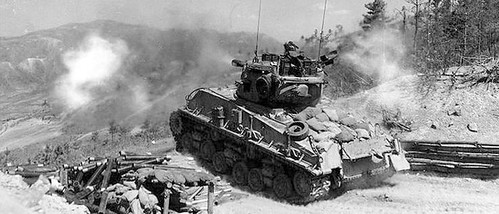The United States decides to send troops to fight in the Korean War.
The Korean War was a conflict that took place on the Korean Peninsula from 1950 to 1953. It was fought between North Korea, supported by China and the Soviet Union, and South Korea, supported by the United Nations, primarily led by the United States. The war had a significant impact on the region and has not officially ended, as a peace treaty was never signed, resulting in an ongoing division between North and South Korea.
The Korean War began on June 25, 1950, when North Korean forces invaded South Korea. The North Koreans aimed to reunify the Korean Peninsula under communist rule. The United Nations Security Council, with the absence of the Soviet Union, passed a resolution condemning the invasion and calling for North Korea to withdraw its forces. A multinational force, predominantly composed of U.S. troops, was assembled to aid South Korea.
The war quickly escalated, with both sides making significant gains and suffering heavy casualties. The North Korean forces pushed deep into the South, capturing Seoul, the capital of South Korea. However, a successful counteroffensive led by the United Nations forces, under the leadership of General Douglas MacArthur, pushed the North Koreans back and recaptured Seoul.
As the UN forces advanced, they crossed the 38th parallel, the original border between North and South Korea. At this point, the war took on a different objective. The UN forces, with the backing of the U.S., aimed to reunify Korea under South Korean control. The Chinese, concerned about a U.S.-led force approaching their border, intervened on behalf of North Korea. The Chinese forces pushed the UN troops back, resulting in a stalemate around the original border.
The war settled into a protracted period of trench warfare, with neither side making significant gains. The fighting was brutal, and both sides suffered heavy casualties. The use of tactics such as air bombardment, artillery, and guerrilla warfare further intensified the conflict.
Negotiations to end the war began in 1951, but it took more than two years to reach an armistice agreement. The Korean Armistice Agreement was signed on July 27, 1953, effectively establishing a ceasefire. It created the Korean Demilitarized Zone (DMZ), a buffer zone that separates North and South Korea. The agreement also called for the repatriation of prisoners of war and established a Military Armistice Commission to oversee the ceasefire.
The Korean War resulted in a significant loss of life and widespread destruction. Estimates of the total casualties vary, but it is believed that over two million people died, including civilians and military personnel from both sides. The war also had a lasting impact on the Korean Peninsula. North Korea became a communist state under the leadership of Kim Il-sung, while South Korea transitioned to a democratic state with strong U.S. support.
To this day, North and South Korea remain divided, with tensions persisting between the two countries. The Korean War is often referred to as the “Forgotten War” due to its overshadowing by World War II and the Vietnam War in popular memory. Nonetheless, its impact on the region and its ongoing ramifications continue to shape the geopolitics of Northeast Asia.

